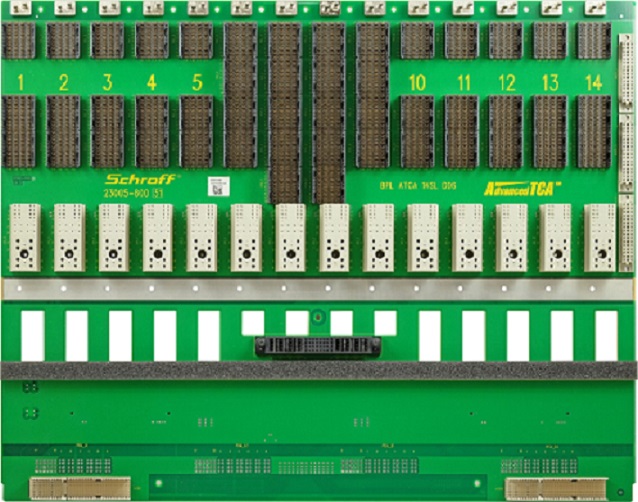
Warwick, R.I. – At the end of 2014, the IEEE association adopted the IEEE802.3bj specification for 100-Gbps Ethernet. Among other things, the specification details the requirements for a 100-Gbps transmission path in printed circuit boards. Since its adoption, PICMG has defined the 100-Gbps requirements for AdvancedTCA backplanes and blades. Pentair introduces its first 100-Gbps Schroff AdvancedTCA backplane, verified according to the design requirements of the IEEE802.3bj specifications for 100-Gbps Ethernet.
The high-data transmission rates of 100 Gbps presented new challenges for connectors, printed circuit board material, and backplane design.
The IEEE802.3bj specification defines two encoding techniques for 100 Gbps: 100GBASE-KR4 (NRZ=PAM2 encoding) and 100GBASE-KP4 (PAM4 encoding). For both encoding techniques, the limit values had to be defined for substantially higher frequency ranges compared to existing 40G rates. For the backplane, this means that all components, connectors, PCB track structures, and the PCB material must be properly designed to accommodate higher frequencies.
As a result, two connector manufacturers have independently developed new 'ZD-compatible' connector types for use at 100 Gbps. This new ZD plug connector for 100G has reduced impedance steps, leading to fewer reflections and better signal transmission.
Careful selection of printed circuit board material also ensures higher transmission rates. All characteristics of the material must be considered, including the loss factor, to make the most ideal selection .
Finally, the optimized printed circuit board design also plays an important role. Not all differential pairs have the same properties. Rather, different strip conductor widths and different layer structures, behave differently with respect to losses and crosstalk. Before completing the design, it is imperative to run a simulation of the complete transmission channel. Pentair recommends the use of the 3D solver software HFSS and ADS for this purpose.
Simulations alone may not be sufficient and require verification once the backplane or board is assembled. Pentair invested in high-quality measuring equipment and used a high-frequency 67Ghz N5227A PNA network analyzer made by Keysight for these types of measurements.
As a result, they have been verified for large production runs and the first backplanes have been delivered and are already being used in ATCA systems.
Advertisement
Learn more about Pentair Electronics Protection, Schroff





